Ministry of Education Distributes Fire Extinguishers to Schools Across St. Kitts
The Ministry of Education in St. Kitts is actively reinforcing its dedication to school safety through the ongoing distribution of fire extinguishers to schools across the island. This initiative forms a crucial component of the Model Safe School Programme, financially supported by the Caribbean Disaster Emergency Management Agency (CDEMA), and underscores the Ministry’s commitment to fostering secure and resilient learning environments. This proactive approach to safety not only equips schools with essential fire suppression tools but also integrates comprehensive training programs to ensure effective usage in emergencies. By prioritizing fire safety, the Ministry aims to mitigate potential risks and create a culture of preparedness within the educational system.
Dr. Tricia Esdaille, the Focal Point for the Safe School Programme, highlighted the significance of safe schools within the broader educational landscape. She emphasized the ongoing collaborative efforts with nine pilot schools, which are the initial recipients of the fire extinguishers. This distribution marks the first phase of a multi-faceted approach to school safety enhancement. Crucially, Dr. Esdaille underscored the commitment to providing comprehensive training throughout the academic year for all staff in schools receiving the extinguishers. This training will cover proper handling and effective deployment techniques, ensuring that personnel are well-equipped to respond confidently and competently in the event of a fire. This proactive training strategy reflects the Ministry’s commitment to not just providing equipment but also empowering staff with the knowledge and skills to utilize it effectively.
Looking forward, the Ministry of Education has charted a comprehensive roadmap for the next phase of the Safe School Programme. This phase will encompass a multi-pronged approach to bolstering safety protocols and procedures across all schools. A key element involves adopting a federal approach to school safety, which aims to standardize safety practices and ensure consistency across the educational system. Furthermore, the Ministry plans to strengthen community connections, recognizing the vital role of collaborative partnerships in fostering safe learning environments. This community engagement will likely involve workshops, awareness campaigns, and collaborative exercises to enhance communication and coordination between schools and their surrounding communities. This integrated approach recognizes that school safety is a shared responsibility that extends beyond the school walls.
The next phase of the program also prioritizes the development of comprehensive school safety plans tailored to each school’s specific needs and context. These plans will outline detailed procedures for various emergency scenarios, including fire evacuations, natural disasters, and other potential threats. Regular school safety drills will be conducted to test and refine these plans, ensuring that staff and students are well-rehearsed and prepared to respond effectively in emergencies. This emphasis on practical training and preparedness will strengthen the overall safety posture of schools and foster a culture of proactive safety consciousness.
Capacity building initiatives for staff and students form another crucial aspect of the Ministry’s comprehensive safety strategy. These initiatives will equip both educators and learners with the necessary skills and knowledge to identify, address, and respond to potential safety incidents. Training programs may cover topics such as first aid, emergency response protocols, and strategies for mitigating various types of safety risks. Empowering both staff and students with these critical skills will not only enhance their individual safety but also contribute to a safer school environment overall. By promoting active participation and preparedness among all stakeholders, the Ministry aims to create a culture of shared responsibility for safety.
School principals have expressed their sincere gratitude for the provision of fire extinguishers, recognizing the significant contribution this initiative makes to safeguarding the well-being of both students and staff. They have affirmed their commitment to ensuring the extinguishers are securely mounted in accessible locations and that all personnel are adequately trained on their correct usage. This proactive approach demonstrates a clear understanding of the importance of fire safety and a commitment to ensuring that these essential tools are readily available and effectively utilized in the event of an emergency. The principals’ commitment to proper installation and training underscores their dedication to creating a safe and secure learning environment for everyone. By prioritizing fire safety preparedness, the Ministry of Education and school leadership demonstrate their unwavering focus on protecting the lives and well-being of the students and staff entrusted to their care. This collaborative effort reinforces the message that safety is a paramount concern and a shared responsibility within the educational community.
Share this content:












Post Comment